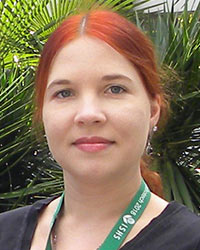Genetic diversity of Tulipa suaveolens in the Crimea based on ISSR data

Tulipa suaveolens Roth (= T. schrenkii Regel) is an ornamental polycarpic species of the Liliaceae family, and a suspected ancestor of T. ×gesneriana L., the garden tulips. Due to the decline in the size of natural species distribution that resulted from the ploughing of the steppes, the International Union for the Conservation of Nature considers this plant to be on the Red List of threatened plants in Russia, Ukraine, Kazakhstan, and Azerbaijan. By comparison with tulips from other areas of the range, T. suaveolens populations of the Crimea and the adjacent territories are highly variable in shape and color of the perianth. Furthermore, mountain populations found at 700 meters above sea level are highly specific in their ecology. The aim of the paper was to conduct inter-simple sequence repeats (ISSR) analysis of intra- and inter-population polymorphism in T. suaveolens specimens found in the Crimea and the adjacent territories, and to reveal the dominant geographic trends in the species distribution. Specimens were collected in natural localities of T. suaveolens in the Crimea, Krasnodar Region, Rostov Oblast, Volgograd Oblast, and Kalmykia Republic. DNA extraction and ISSR analysis were performed using standard procedures. The analysis gave 153 polymorphous T. suaveolens bands. Principal coordinate analysis (PCA) of the matrix in the Paleontological Statistics (PAST) software indicated that the populations from Kalmykia and the Krasnodar Region were genetically isolated, whereas specimens from the remaining populations were mixed. The analysis in the NewHybrids software confirmed the results of the PCA, though in a small number of iterations. In these iterations, the program identified the populations from Kalmykia and the Krasnodar Region as “pure parents”, while the remaining specimens were classified as F2 hybrids. However, in analyses with more iterations, the “parent” status was assigned only to the Kalmykian population, while other specimens fell into the “backcrosses” category, grouping to the second, absent parent. The Bayesian analysis using STRUCTURE software resulted in the separation of the dataset into four groups according to their geographic distribution. Nonetheless, ISSR analysis allowed for only tentative conclusions and needs to be supported by other methods of research.
Tatyana Kritskaya won an ISHS Young Minds Award for the best oral presentation at the VIII International Scientific and Practical Conference on Biotechnology as an Instrument for Plant Biodiversity Conservation (physiological, biochemical, embryological, genetic and legal aspects) in Yalta, Russia, in October 2018.
Dr. Tatyana Kritskaya, Chernyshevsky Saratov State University, 83 Astrakhanskaya str., Saratov, 410012, Russian Federation, e-mail: kritckaiata@gmail.com
The article is available in Chronica Horticulturae
Comments
Congratulation.